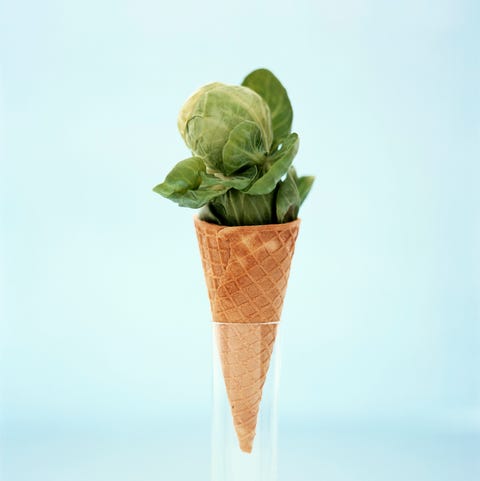

Oat milk lattes and CBD gummies reigned supreme in 2018, but with a new year comes a new crop of up-and-coming food trends. And, frankly, 2019 is shaping up to be pretty damn delicious.
While the idea of food trends might seem ridiculous—nothing is ever really new, and food is food—hopping on board the trend train can be a great way to vary your diet, try new things, and keep healthy eating interesting and fun.
Keep in mind: Many of these trends highlight foods that have been popular staples in other cultures for centuries—they may be new to you, but they definitely existed elsewhere long before Instagram.
Now, prepare for some major grocery inspo—these are all the biggest food trends coming for you in 2019.
1. Nut butter will make way for seed butter.
Peanut butter is a classic, and alternative nut butters like almond and cashew have been buzzy for years. And, while seed butters like sunflower seed butter and tahini are nothing new—in fact, tahini has been a staple in Middle Eastern cuisine for centuries—expect to start seeing them everywhere in 2019.
“Keep an eye out for sunflower, pumpkin, and watermelon seed butters, which share the same good fat profile of nut butters, but may offer an alternative for those with nut allergies,” reads the KIND 2019 Healthy Snacking Trend Report. Experts are on board with this trend, but Miho Hatanaka, R.D. recommends steering clear of brands with added sugars and instead sticking to those made with just seeds and sea salt.
2. “Ugly” food will shine.
Food companies have long been in the habit of trashing ingredients that aren’t pretty enough to sell, but conscious consumers are catching wind. The battle against food waste isn’t new—chef Dan Barber’s wasteED campaign encourages the use of food scraps and “ugly” produce in restaurants, and plenty of farmers and merchants outside of the big supermarket chains have never been shy about selling misshapen goods. But it’ll gain even more momentum in 2019.
View this post on Instagram
A post shared by Sustainable Homestead (@sustainable_homestead) on
Pretty food isn’t any healthier than the less Insta-worthy stuff, and reducing food waste is important for the planet. So, get on board with those crooked carrots.
3. Harissa will make its way into every pantry.
No need to get rid of your poultry seasoning and ground cumin, but plan to make room for flavor-packed seasonings like harissa, berbere, dukkah, and ras el hanout, all of which are heavily used in African cuisine.
Harissa—a slightly spicy paste made with red pepper, tomato, chili, and a few other spices and aromatics—is easy to swap for tomato paste in almost any recipe, and packs a similar nutritional punch. If it’s new to you, Deborah Murphy, R.D., recommends experimenting with harissa tomato sauce (like this one on her blog), which you can make a big batch of for easy weeknight pastas or veggie bowls.
4. Added sugar will get another demerit.
Manufacturers won’t technically need to list added sugars separately from naturally occurring ones on packaging until January 2020, according to the FDA. But KIND predicts you’ll see the “added sugar” line to pop up on most nutrition labels next year.
Experts are mostly in favor of this. Naturally occurring sugars from fruits and vegetables come with fiber, which slows digestion and provides steady energy without a blood sugar spike and crash, explains Germaine Guy, R.D. Likewise, the sugars found in dairy come packaged with satisfying protein and fat. Added sugars (think: cane sugar and corn syrup) don’t add nutritional value, which is why the USDA dietary guidelines recommend limiting them to less than 10 percent of your total daily calories.
That said, there’s no need to go totally crazy and eliminate all added sugar from your diet—sweets are fine in moderation!
5. Coconut water will have competition.
For years, coconut water has been marketed (to great success) as a hydration miracle, hangover cure, and all-around delicious alternative to regular old water. In 2019, look out for other alternative waters to take over the beverage case.
The KIND Healthy Snacks Trend Report calls out two in particular: “Maple water, which contains less than half of the sugar of coconut water, as well as cactus water, which is promoted for skin revitalization.”
While these slightly sweet waters won’t hurt you, the Academy of Nutrition Dietetics says to be wary of their lofty claims. They won’t do a better job of hydrating you than regular old H20, and they have sugar without any fiber, so drinking too much could lead to a blood sugar spike.
6. Vitamins and supplements are on the outs.
Although we’re more wellness-obsessed than ever, the KIND trend report predicts that processed vitamins and supplements will finally be on their way out. Instead, we’re shifting toward a sharper focus on meeting nutrient needs with whole foods.
This isn’t new. The USDA dietary guidelines clearly state that “nutritional needs should be met primarily from foods, and the Academy of Nutrition and Dietetics has long advised meeting nutrient needs by eating as varied a diet as possible, instead of relying on expensive vitamins and supplements (which, BTW, don’t need FDA approval and may not even contain the nutrients they say they do).
7. Probiotics will be on your shelf, not just in your fridge.
Research on gut health is growing, in large part because scientists are hopeful that a better understanding of the human microbiome can lead to improved public health. For years, probiotics have been touted as a great way to increase healthy bacteria in the gut—fermented foods like kimchi and yogurt, plus refrigerated pills and formulas have been the go-to delivery method for these bacteria.



This year, expect probiotics to show up in shelf-stable products. “Wellness-focused brands are making it easier to get more probiotics in your day by adding functional probiotic ingredients to your pantry staples through products like granola, oatmeal, nut butters, soups and nutrition bars,” says the latest 2019 trend report from Whole Foods.
While there’s probably nothing wrong with probiotic-enriched cornflakes, the science on probiotics is still in early stages, and there’s really no way to be sure that you’re actually getting the healthy bacteria touted on the labels of these foods.
Look for labels that read, “live and active cultures,” says Bonnie Taub-Dix, R.D. This means there are at least 100 million bacteria per gram.
8. Jackfruit will be the new go-to meat substitute.
“Jackfruit is a popular meat alternative already being used in place of items like barbecue pulled pork,” according to the Whole Foods trend report. The fruit is native to Southeast Asia, and is also grown in parts of Africa and South America. Americans have been using it as a meat substitute for a few years now (thanks to a stringy texture that mimics pulled pork or beef), but 2019 will be the year that pulled jackfruit really takes off.
View this post on Instagram
A post shared by Amanda Mackenzie (@amandaswholesomekitchen) on
“Jackfruit is a good source of iron, calcium, and B vitamins, and using it as a replacement for meat helps you cut calories and saturated fat from your diet,” says Taub-Dix. “However, it should be noted that jackfruit has a much lower protein content compared to meat, at 2.8 grams per serving versus around 21 grams, as well as 31 grams of sugar per cup, sliced.” Compare that to a cup of sliced banana which has
9. Your fruit basket will get a tropical spin.
Sick of acai? You may be in luck. Whole Foods is predicting that tropical fruits like guava, dragonfruit, starfruit, and passionfruit will take center stage this year.
If you’re sick of your usual apple a day, swap in one of these tropical fruits every once in a while. Different fruits have slightly different nutrient profiles, but all are packed with fiber, vitamins, and healthy carbs, explains Keri Gans, R.D., author of The Small Change Diet. Any type of fruit is a great choice for a snack or as part of a meal, and changing things up can help keep you excited about getting your five-a-day.
10. Faux meat will be your go-to snack.
According to the Whole Foods report, snacks like mushroom-based faux cracklin’, soy-based jerky, and mushroom “bacon chips” will continue to gain momentum in 2019, as an alternative to classic packaged meat snacks like beef jerky and pork rinds.

Taub-Dix is on board with this shift to faux-meat snacks. “The protein that comes from plant foods can count towards your daily intake,” she says. While individual plant-based proteins aren’t complete proteins, you can get all of the essential amino acids (the building blocks of both protein and our own lean tissue) by eating several different types of plant-based protein.
Meat alternative snacks made with vegetables, like mushrooms, generally don’t have much protein, but are still a nutritious snack choice. Just keep noshing on other healthy plant based snacks, too, advises Taub-Dix.
11. Your grocery shopping experience will go high-tech.
Counting calories and macros works for some people, but plenty of people don’t want to be quite so dialed into exactly what they’re eating all the time. Kroger is trying to make healthy eating a little bit more effortless with their new app, OptUP, which keeps track of the groceries you buy and uses the personalized information to make suggestions for healthy swaps and better food choices.
Allison Kuhn, R.D., director of nutrition at Kroger, explains that the app takes into account your current buying and eating pattern, and aims to nudge you towards slightly healthier choices. It’s about achieving a healthy balance overall, she says, not about logging every food or making you feel guilty for individual food choices.
12. Frozen treats made of avocado, hummus, and coconut water will invade freezers.
Banana soft serve is so 2016, and dairy-free ice creams made with alternative milks are finally catching up to cream-based versions in both the flavor and texture departments, according to the Whole Foods trend report.
This year, brands will take things a step further by experimenting with new ice cream bases like hummus, avocado, and tahini. “I love this, because when your base is something nutrient-dense, like chickpeas or avocado, you’re guaranteed to be getting some good stuff,” says Kuhn. She explains that frozen treats are a great way for brands to experiment with different ingredients because they don’t spoil the way fresh food does.
The jury’s still out on whether avocado ice cream will hold up to the original, but go ahead and experiment with a few new dairy-free ice creams and see if any strike your fancy.
13. Dessert hummus will be a *thing*.
While there’s nothing wrong with filling a cookie dough craving with some actual cookie dough every once in a while, Kuhn loves the new dessert hummus options available in stores these days, and thinks they’ll get even more popular in the new year. “If it’s something I crave, I’d rather opt for something a little bit healthier,” she explains.
These chickpea-based desserts generally contain added sugar, so they’re not exactly a health food, but they also pack fiber and protein that isn’t found in traditional dessert.
View this post on Instagram
A post shared by Devika Sharma • Dietitian (@onemorebite.dietitian) on
14. You might finally learn how to bake bread.
“Bread baking is on the rise, especially when it comes to fermented loaves like sourdough,” according to the Pinterest’s 100 top trends for 2019. Kuhn agrees that people are increasingly interested in cooking more at home, and that baking bread can be a fun and delicious culinary experience.
But, she says it’s still totally fine to just buy your loaf. “On the market today, there are a lot of extremely healthy breads, so you can find great options,” she says. Look for 100-percent whole grain on the label, and mix things up by trying a bread baked with a new-to-you grain, like amaranth or kamut.
Source: Read Full Article